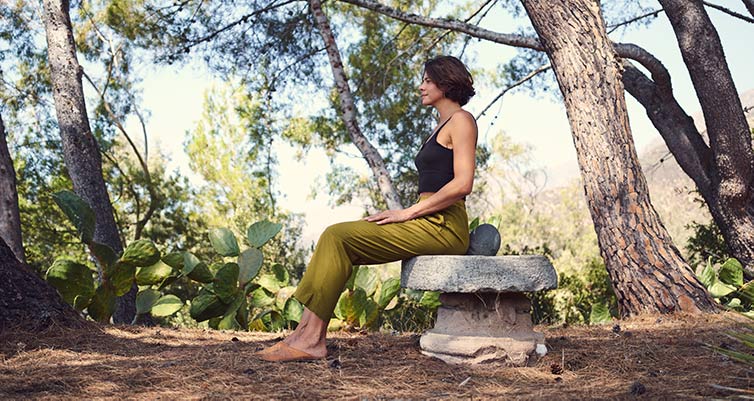Mindfulness Exercises
Category: Beginners Guide to Meditation | How to Meditate

4 beneficial mindful techniques and activities you can try today
Mindfulness is so popular these days that there’s no shortage of quick, creative mindfulness exercises available through websites, apps, and in print, not to mention in live classes online or in person. Here are four curated breath and mind-body exercises that you can easily experiment with in your own space. You’ll see that some are particularly well-suited for children and teens.
1) Counting breathing cycles
Counting breathing cycles during meditation is one of a number of simple mindfulness exercises found in traditional, centuries-old meditation manuals. Counting provides an additional anchor for the active mind which some meditators find quite helpful.
For this meditation, sit quietly on a chair, on a cushion, in your car or in nature. Focus your attention on the breath. When your mind and breathing are in sync, start to count the breathing cycles: inhale, exhale, one; inhale, exhale, two; and so on for ten minutes–count from one to seven and seven to one. Then start again. If seven is too hard, see if you can maintain your attention up to three. If seven is too easy, try counting to ten or twenty-one.
This is a straightforward and accessible mindfulness breathing exercise for adults that can easily be integrated into a busy work day. In the article How to Practice Mindfulness Throughout Your Work Day, Harvard Business Review offers a guided audio ten-minute breathing exercise that takes you from one to ten and back again.
2) A mindful morsel
This is one the top mindfulness exercises for kids. In the form of “the raisin meditation” this classic mindfulness-based stress reduction exercise usually kicks off MBSR courses using (wait for it)… raisins as the focus of meditation. But as one of those fun mindfulness exercises you can share with young folk, any morsel of food that isn’t going to melt or become too sticky will do: raisins, other dried fruits (dried pineapple is great for this), granola clusters, or anything else that is likely to hold their interest. The idea is to get the kids to pay close attention to the morsel–the closer the better.
There are several stages but the order can vary.
• Close looking,
• Close touching,
• Attention to smelling,
• Attention to movement and contact,
• Attention to taste,
• Attention to chewing and swallowing.
If you’re leading kids in this for the very first time, it can be especially fun to go into it without their knowing what they’re getting into. Have them close or cover their eyes, then stretch out a hand so you can place a morsel in their palm. Have them begin with smelling and touching before they’re allowed to open their eyes and look. See UC Berkeley’s Greater Good Science Center for an easy-to-follow script of the raisin meditation mindfulness exercise.
A great exercise to improve focus, this 5-minute mindfulness exercise opens children’s horizons to the power of close attention. They learn that if they’re able to tune out the distractions, there’s just so much to appreciate about the world around them.
3) Mindfully tense and relax
This is a tried-and-true mindfulness exercise for anxiety control that’s well-suited for kids and teens as well as for adults. It’s best practiced while lying down comfortably on the floor or the bed.
In its simplest form, you begin by lying still for a minute or two and paying close attention to the body with an informal scan. Note where there’s tension, but don’t work with it yet. Simply observe, accept, and move on. Spend a short time observing the body’s expression of the breathing process.
Next, tense your muscles progressively—don’t force it! Gradually clench your muscles and tense the whole body, then gradually relax completely. Do your best to remain present with the experience. Repeat at least twice.
Alternatively, you can begin squeezing and tensing muscles at the feet: toes, feet, ankles, calves, etc., and work your way up. Don’t over-think it. Once you get to the top, maintain the tension for a few moments, then relax. Slowly work your way back down from the head—scalp, temples, forehead, clenched teeth, jaw, neck and so on—to your toes. Relax entirely and come back to awareness of breathing. This exercise can take some time, but it’s deeply calming when done attentively.
The University of Michigan’s on-line health library presents a more detailed muscle relaxation exercise which calls attention to different muscle groups successively. It can be used as a stress-busting guided mindfulness exercise for groups of all ages if there’s enough space, or try reading it to a few reclining kids at a time and see how they respond.
4) A Mindful SEAT
Psychologist Dr. Christopher Willard, who is also a meditator, author, and professor at Harvard Medical School, proposes a method he calls the Mindful SEAT. This mind-body check-in, as presented in his book Raising Resilience: The Wisdom and Science of Happy Families and Thriving Children, is especially geared towards helping children and teens apply mindfulness to improve focus and better manage stressful, situations and transitions. But there’s no reason why adults shouldn’t benefit from applying the acronym as well.
Points for mindful reflection:
• Senses/Sensations. Check in with physical sensations: What am I feeling? What are my senses communicating and how is my body reacting?
• Emotions. What emotions are being triggered?
• Actions. What does this make me feel like doing?
• Thoughts. Can I recognize the thoughts that arise as a result of this?
This exercise in mindfulness of feelings and reactions can be done as a check-in any time you’re aware of strong emotions or at random moments during the day. Dr. Willard suggests sitting and taking a few deep, conscious breaths before proceeding with the 4-step check-in. If you’re practicing with others, you can share your observations.






